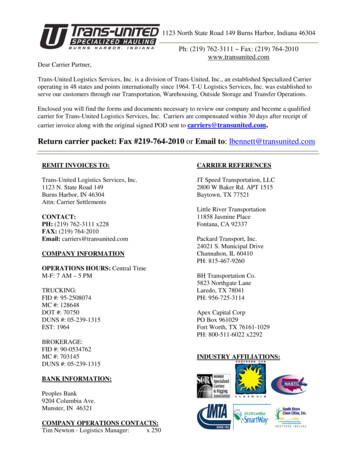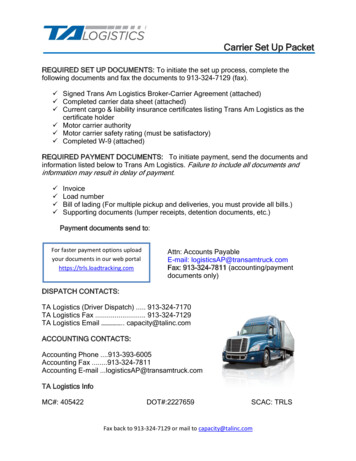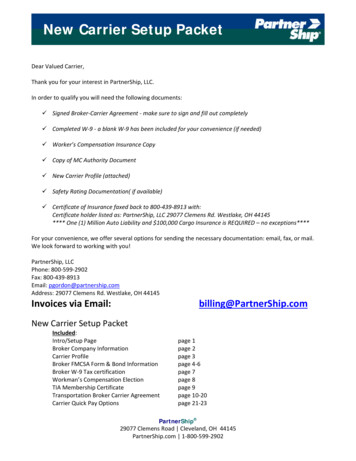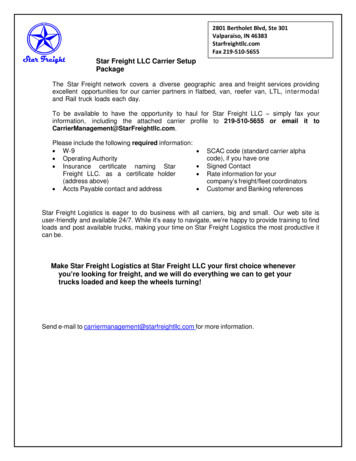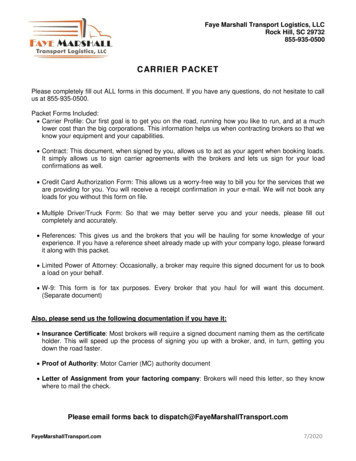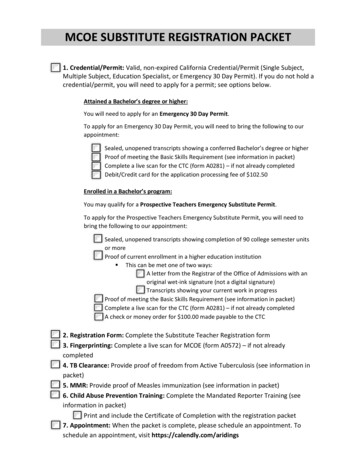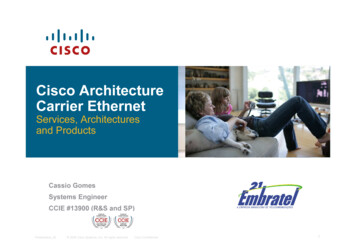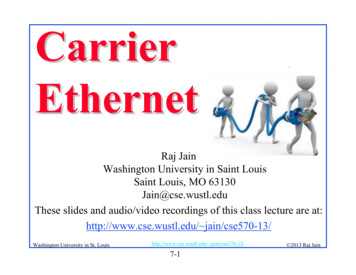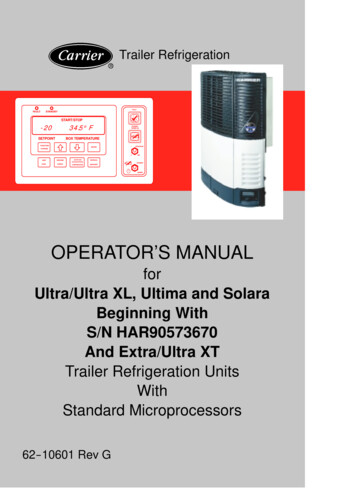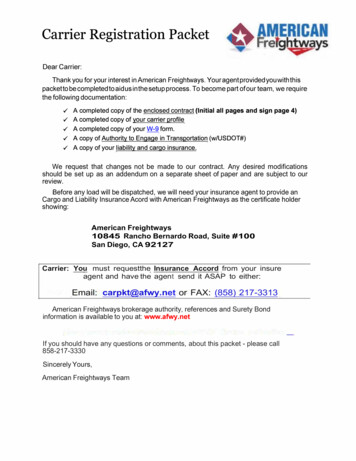
Transcription
Carrier Registration Packet FreDear Carrier:Thank you for your interest in American Freightways. Your agent provided you with thispacket to be completed to aid us in the setup process. To become part of our team, we requirethe following documentation: A completed copy of the enclosed contract (Initial all pages and sign page 4)A completed copy of your carrier profileA completed copy of your W-9 form.A copy of Authority to Engage in Transportation (w/USDOT#)A copy of your liability and cargo insurance.We request that changes not be made to our contract. Any desired modificationsshould be set up as an addendum on a separate sheet of paper and are subject to ourreview.Before any load will be dispatched, we will need your insurance agent to provide anCargo and Liability Insurance Acord with American Freightways as the certificate holdershowing:American Freightways10845 Rancho Bernardo Road, Suite #100San Diego, CA 92127Carrier: You must requestthe Insurance Accord from your insureagent and have the agent send it ASAP to either:Email: carpkt@afwy.net or FAX: (858) 217-3313American Freightways brokerage authority, references and Surety Bondinformation is available to you at: www.afwy.netIf you should have any questions or comments, about this packet - please call858-217-3330Sincerely Yours,American Freightways Team
Carrier ReferencesAttention New CarriersWith authority issued less than one year ago.If you have been in business for less than one year, please provide us with threecustomer references to allow us to verify your reliability as a carrier.If you do not provide us with a name, a company name and a phone number, wewill not be able to pursue the reference and will consider you as non responsive.References for use to verify the carrier s reliability:Contact 1:Contact Name:Company Name:Contact Phone Number:Date of Last Load:Carrier s ReferenceAmerican Freightways ResultCarrier s ReferenceAmerican Freightways ResultCarrier s ReferenceAmerican Freightways ResultContact 2:Contact Name:Company Name:Contact Phone Number:Date of Last Load:Contact 3:Contact Name:Company Name:Contact Phone Number:Date of Last Load:
W-9Form(Rev. October 2018)Department of the TreasuryInternal Revenue ServiceRequest for TaxpayerIdentification Number and Certification Give Form to therequester. Do notsend to the IRS.Go to www.irs.gov/FormW9 for instructions and the latest information.1 Name (as shown on your income tax return). Name is required on this line; do not leave this line blank.Print or type.See Specific Instructions on page 3.2 Business name/disregarded entity name, if different from above4 Exemptions (codes apply only tocertain entities, not individuals; seeinstructions on page 3):3 Check appropriate box for federal tax classification of the person whose name is entered on line 1. Check only one of thefollowing seven boxes.Individual/sole proprietor orsingle-member LLCC CorporationS CorporationPartnershipTrust/estateExempt payee code (if any)Limited liability company. Enter the tax classification (C C corporation, S S corporation, P Partnership) Note: Check the appropriate box in the line above for the tax classification of the single-member owner. Do not check Exemption from FATCA reportingLLC if the LLC is classified as a single-member LLC that is disregarded from the owner unless the owner of the LLC iscode (if any)another LLC that is not disregarded from the owner for U.S. federal tax purposes. Otherwise, a single-member LLC thatis disregarded from the owner should check the appropriate box for the tax classification of its owner.Other (see instructions) 5 Address (number, street, and apt. or suite no.) See instructions.(Applies to accounts maintained outside the U.S.)Requester’s name and address (optional)6 City, state, and ZIP code7 List account number(s) here (optional)Part ITaxpayer Identification Number (TIN)Enter your TIN in the appropriate box. The TIN provided must match the name given on line 1 to avoidbackup withholding. For individuals, this is generally your social security number (SSN). However, for aresident alien, sole proprietor, or disregarded entity, see the instructions for Part I, later. For otherentities, it is your employer identification number (EIN). If you do not have a number, see How to get aTIN, later.Note: If the account is in more than one name, see the instructions for line 1. Also see What Name andNumber To Give the Requester for guidelines on whose number to enter.Part IISocial security number––orEmployer identification number–CertificationUnder penalties of perjury, I certify that:1. The number shown on this form is my correct taxpayer identification number (or I am waiting for a number to be issued to me); and2. I am not subject to backup withholding because: (a) I am exempt from backup withholding, or (b) I have not been notified by the Internal RevenueService (IRS) that I am subject to backup withholding as a result of a failure to report all interest or dividends, or (c) the IRS has notified me that I amno longer subject to backup withholding; and3. I am a U.S. citizen or other U.S. person (defined below); and4. The FATCA code(s) entered on this form (if any) indicating that I am exempt from FATCA reporting is correct.Certification instructions. You must cross out item 2 above if you have been notified by the IRS that you are currently subject to backup withholding becauseyou have failed to report all interest and dividends on your tax return. For real estate transactions, item 2 does not apply. For mortgage interest paid,acquisition or abandonment of secured property, cancellation of debt, contributions to an individual retirement arrangement (IRA), and generally, paymentsother than interest and dividends, you are not required to sign the certification, but you must provide your correct TIN. See the instructions for Part II, later.SignHereSignature ofU.S. person Date General InstructionsSection references are to the Internal Revenue Code unless otherwisenoted.Future developments. For the latest information about developmentsrelated to Form W-9 and its instructions, such as legislation enactedafter they were published, go to www.irs.gov/FormW9.Purpose of FormAn individual or entity (Form W-9 requester) who is required to file aninformation return with the IRS must obtain your correct taxpayeridentification number (TIN) which may be your social security number(SSN), individual taxpayer identification number (ITIN), adoptiontaxpayer identification number (ATIN), or employer identification number(EIN), to report on an information return the amount paid to you, or otheramount reportable on an information return. Examples of informationreturns include, but are not limited to, the following. Form 1099-INT (interest earned or paid)Cat. No. 10231X Form 1099-DIV (dividends, including those from stocks or mutualfunds) Form 1099-MISC (various types of income, prizes, awards, or grossproceeds) Form 1099-B (stock or mutual fund sales and certain othertransactions by brokers) Form 1099-S (proceeds from real estate transactions) Form 1099-K (merchant card and third party network transactions) Form 1098 (home mortgage interest), 1098-E (student loan interest),1098-T (tuition) Form 1099-C (canceled debt) Form 1099-A (acquisition or abandonment of secured property)Use Form W-9 only if you are a U.S. person (including a residentalien), to provide your correct TIN.If you do not return Form W-9 to the requester with a TIN, you mightbe subject to backup withholding. See What is backup withholding,later.Form W-9 (Rev. 10-2018)
Page 2Form W-9 (Rev. 10-2018)By signing the filled-out form, you:1. Certify that the TIN you are giving is correct (or you are waiting for anumber to be issued),2. Certify that you are not subject to backup withholding, or3. Claim exemption from backup withholding if you are a U.S. exemptpayee. If applicable, you are also certifying that as a U.S. person, yourallocable share of any partnership income from a U.S. trade or businessis not subject to the withholding tax on foreign partners' share ofeffectively connected income, and4. Certify that FATCA code(s) entered on this form (if any) indicatingthat you are exempt from the FATCA reporting, is correct. See What isFATCA reporting, later, for further information.Note: If you are a U.S. person and a requester gives you a form otherthan Form W-9 to request your TIN, you must use the requester’s form ifit is substantially similar to this Form W-9.Definition of a U.S. person. For federal tax purposes, you areconsidered a U.S. person if you are: An individual who is a U.S. citizen or U.S. resident alien; A partnership, corporation, company, or association created ororganized in the United States or under the laws of the United States; An estate (other than a foreign estate); or A domestic trust (as defined in Regulations section 301.7701-7).Special rules for partnerships. Partnerships that conduct a trade orbusiness in the United States are generally required to pay a withholdingtax under section 1446 on any foreign partners’ share of effectivelyconnected taxable income from such business. Further, in certain caseswhere a Form W-9 has not been received, the rules under section 1446require a partnership to presume that a partner is a foreign person, andpay the section 1446 withholding tax. Therefore, if you are a U.S. personthat is a partner in a partnership conducting a trade or business in theUnited States, provide Form W-9 to the partnership to establish yourU.S. status and avoid section 1446 withholding on your share ofpartnership income.In the cases below, the following person must give Form W-9 to thepartnership for purposes of establishing its U.S. status and avoidingwithholding on its allocable share of net income from the partnershipconducting a trade or business in the United States. In the case of a disregarded entity with a U.S. owner, the U.S. ownerof the disregarded entity and not the entity; In the case of a grantor trust with a U.S. grantor or other U.S. owner,generally, the U.S. grantor or other U.S. owner of the grantor trust andnot the trust; and In the case of a U.S. trust (other than a grantor trust), the U.S. trust(other than a grantor trust) and not the beneficiaries of the trust.Foreign person. If you are a foreign person or the U.S. branch of aforeign bank that has elected to be treated as a U.S. person, do not useForm W-9. Instead, use the appropriate Form W-8 or Form 8233 (seePub. 515, Withholding of Tax on Nonresident Aliens and ForeignEntities).Nonresident alien who becomes a resident alien. Generally, only anonresident alien individual may use the terms of a tax treaty to reduceor eliminate U.S. tax on certain types of income. However, most taxtreaties contain a provision known as a “saving clause.” Exceptionsspecified in the saving clause may permit an exemption from tax tocontinue for certain types of income even after the payee has otherwisebecome a U.S. resident alien for tax purposes.If you are a U.S. resident alien who is relying on an exceptioncontained in the saving clause of a tax treaty to claim an exemptionfrom U.S. tax on certain types of income, you must attach a statementto Form W-9 that specifies the following five items.1. The treaty country. Generally, this must be the same treaty underwhich you claimed exemption from tax as a nonresident alien.2. The treaty article addressing the income.3. The article number (or location) in the tax treaty that contains thesaving clause and its exceptions.4. The type and amount of income that qualifies for the exemptionfrom tax.5. Sufficient facts to justify the exemption from tax under the terms ofthe treaty article.Example. Article 20 of the U.S.-China income tax treaty allows anexemption from tax for scholarship income received by a Chinesestudent temporarily present in the United States. Under U.S. law, thisstudent will become a resident alien for tax purposes if his or her stay inthe United States exceeds 5 calendar years. However, paragraph 2 ofthe first Protocol to the U.S.-China treaty (dated April 30, 1984) allowsthe provisions of Article 20 to continue to apply even after the Chinesestudent becomes a resident alien of the United States. A Chinesestudent who qualifies for this exception (under paragraph 2 of the firstprotocol) and is relying on this exception to claim an exemption from taxon his or her scholarship or fellowship income would attach to FormW-9 a statement that includes the information described above tosupport that exemption.If you are a nonresident alien or a foreign entity, give the requester theappropriate completed Form W-8 or Form 8233.Backup WithholdingWhat is backup withholding? Persons making certain payments to youmust under certain conditions withhold and pay to the IRS 24% of suchpayments. This is called “backup withholding.” Payments that may besubject to backup withholding include interest, tax-exempt interest,dividends, broker and barter exchange transactions, rents, royalties,nonemployee pay, payments made in settlement of payment card andthird party network transactions, and certain payments from fishing boatoperators. Real estate transactions are not subject to backupwithholding.You will not be subject to backup withholding on payments youreceive if you give the requester your correct TIN, make the propercertifications, and report all your taxable interest and dividends on yourtax return.Payments you receive will be subject to backup withholding if:1. You do not furnish your TIN to the requester,2. You do not certify your TIN when required (see the instructions forPart II for details),3. The IRS tells the requester that you furnished an incorrect TIN,4. The IRS tells you that you are subject to backup withholdingbecause you did not report all your interest and dividends on your taxreturn (for reportable interest and dividends only), or5. You do not certify to the requester that you are not subject tobackup withholding under 4 above (for reportable interest and dividendaccounts opened after 1983 only).Certain payees and payments are exempt from backup withholding.See Exempt payee code, later, and the separate Instructions for theRequester of Form W-9 for more information.Also see Special rules for partnerships, earlier.What is FATCA Reporting?The Foreign Account Tax Compliance Act (FATCA) requires aparticipating foreign financial institution to report all United Statesaccount holders that are specified United States persons. Certainpayees are exempt from FATCA reporting. See Exemption from FATCAreporting code, later, and the Instructions for the Requester of FormW-9 for more information.Updating Your InformationYou must provide updated information to any person to whom youclaimed to be an exempt payee if you are no longer an exempt payeeand anticipate receiving reportable payments in the future from thisperson. For example, you may need to provide updated information ifyou are a C corporation that elects to be an S corporation, or if you nolonger are tax exempt. In addition, you must furnish a new Form W-9 ifthe name or TIN changes for the account; for example, if the grantor of agrantor trust dies.PenaltiesFailure to furnish TIN. If you fail to furnish your correct TIN to arequester, you are subject to a penalty of 50 for each such failureunless your failure is due to reasonable cause and not to willful neglect.Civil penalty for false information with respect to withholding. If youmake a false statement with no reasonable basis that results in nobackup withholding, you are subject to a 500 penalty.
Page 3Form W-9 (Rev. 10-2018)Criminal penalty for falsifying information. Willfully falsifyingcertifications or affirmations may subject you to criminal penaltiesincluding fines and/or imprisonment.Misuse of TINs. If the requester discloses or uses TINs in violation offederal law, the requester may be subject to civil and criminal penalties.Specific InstructionsLine 1You must enter one of the following on this line; do not leave this lineblank. The name should match the name on your tax return.If this Form W-9 is for a joint account (other than an accountmaintained by a foreign financial institution (FFI)), list first, and thencircle, the name of the person or entity whose number you entered inPart I of Form W-9. If you are providing Form W-9 to an FFI to documenta joint account, each holder of the account that is a U.S. person mustprovide a Form W-9.a. Individual. Generally, enter the name shown on your tax return. Ifyou have changed your last name without informing the Social SecurityAdministration (SSA) of the name change, enter your first name, the lastname as shown on your social security card, and your new last name.Note: ITIN applicant: Enter your individual name as it was entered onyour Form W-7 application, line 1a. This should also be the same as thename you entered on the Form 1040/1040A/1040EZ you filed with yourapplication.b. Sole proprietor or single-member LLC. Enter your individualname as shown on your 1040/1040A/1040EZ on line 1. You may enteryour business, trade, or “doing business as” (DBA) name on line 2.c. Partnership, LLC that is not a single-member LLC, Ccorporation, or S corporation. Enter the entity's name as shown on theentity's tax return on line 1 and any business, trade, or DBA name online 2.d. Other entities. Enter your name as shown on required U.S. federaltax documents on line 1. This name should match the name shown on thecharter or other legal document creating the entity. You may enter anybusiness, trade, or DBA name on line 2.e. Disregarded entity. For U.S. federal tax purposes, an entity that isdisregarded as an entity separate from its owner is treated as a“disregarded entity.” See Regulations section 301.7701-2(c)(2)(iii). Enterthe owner's name on line 1. The name of the entity entered on line 1should never be a disregarded entity. The name on line 1 should be thename shown on the income tax return on which the income should bereported. For example, if a foreign LLC that is treated as a disregardedentity for U.S. federal tax purposes has a single owner that is a U.S.person, the U.S. owner's name is required to be provided on line 1. Ifthe direct owner of the entity is also a disregarded entity, enter the firstowner that is not disregarded for federal tax purposes. Enter thedisregarded entity's name on line 2, “Business name/disregarded entityname.” If the owner of the disregarded entity is a foreign person, theowner must complete an appropriate Form W-8 instead of a Form W-9.This is the case even if the foreign person has a U.S. TIN.Line 2If you have a business name, trade name, DBA name, or disregardedentity name, you may enter it on line 2.Line 3Check the appropriate box on line 3 for the U.S. federal taxclassification of the person whose name is entered on line 1. Check onlyone box on line 3.IF the entity/person on line 1 isa(n) . . .THEN check the box for . . . CorporationCorporation IndividualIndividual/sole proprietor or singlemember LLC Sole proprietorship, or Single-member limited liabilitycompany (LLC) owned by anindividual and disregarded for U.S.federal tax purposes. LLC treated as a partnership forU.S. federal tax purposes, LLC that has filed Form 8832 or2553 to be taxed as a corporation,or LLC that is disregarded as anentity separate from its owner butthe owner is another LLC that isnot disregarded for U.S. federal taxpurposes.Limited liability company and enterthe appropriate tax classification.(P Partnership; C C corporation;or S S corporation) Partnership Trust/estatePartnershipTrust/estateLine 4, ExemptionsIf you are exempt from backup withholding and/or FATCA reporting,enter in the appropriate space on line 4 any code(s) that may apply toyou.Exempt payee code. Generally, individuals (including sole proprietors) are not exempt frombackup withholding. Except as provided below, corporations are exempt from backupwithh
American Freightways brokerage authority, references and Surety Bond information is available to you at: www.afwy.net If you should have any questions or comments, about this packet - please call 858-217-3330 Sincerely Yours, A
